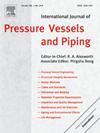全面回顾在役管道修复方法,重点是轴向应变能力
IF 3.5
2区 工程技术
Q2 ENGINEERING, MECHANICAL
International Journal of Pressure Vessels and Piping
Pub Date : 2025-07-17
DOI:10.1016/j.ijpvp.2025.105607
引用次数: 0
摘要
管道为石油和天然气产品提供了一种可靠、经济的运输方式。然而,它们的完整性可能会受到缺陷和地质灾害的威胁,因此在役维修方法对于维护安全性、确保连续运行和支持长期可持续性至关重要。本文以轴向应变能力为重点,评价了不同的在役管道修复方法。在地质灾害易发地区,修复对管道完整性至关重要,因为这些地区的地面运动(如滑坡和下沉)会引起显著的轴向应变。该综述深入分析了这些修复方法的设计功能和实际应用,同时讨论了它们面临的挑战和最新进展。基于缺陷覆盖率、执行的便利性、灵活性和成本效益的修复方法的比较评估包括选择最合适的修复技术。此外,该综述确定了当前在提高轴向应变能力方面的挑战,并强调了未来研究的重要性。进一步的研究需要优化套管的几何形状和焊接结构,改进安装方法,并研究浆液和填充材料的长期行为和界面粘合,因为这些因素对于提高轴向和环向应变能力,提高管道的整体弹性和寿命至关重要。本文章由计算机程序翻译,如有差异,请以英文原文为准。
A comprehensive review of in-service pipeline repair methods with a focus on axial strain capacity
Pipelines provide a reliable, cost-effective transport method for oil and gas products. However, their integrity can be threatened by defects and geohazards, making in-service repair methods crucial for maintaining safety, ensuring continuous operation, and supporting long-term sustainability. This review evaluates different in-service pipeline repair methods focusing on axial strain capacity. Repair is crucial for pipeline integrity in geohazard-prone regions where ground movements, such as landslides and subsidence, can induce significant axial strain. The review provides an in-depth analysis of these repair methods' design functionality and real-world applications while discussing their challenges and recent advancements. A comparative assessment of repair methods based on defect coverage, ease of execution, flexibility, and cost-effectiveness is included to select the most suitable repair techniques. Additionally, the review identifies current challenges in improving axial strain capacity and underscores the importance of future research. Further studies are required to optimize sleeve geometry and weld configurations, improve installation practices, and investigate the long-term behavior and interfacial bonding of grout and filler materials, as these factors are critical to enhance axial and hoop strain capacities and improve the pipeline's overall resilience and longevity.
求助全文
通过发布文献求助,成功后即可免费获取论文全文。
去求助
来源期刊
CiteScore
5.30
自引率
13.30%
发文量
208
审稿时长
17 months
期刊介绍:
Pressure vessel engineering technology is of importance in many branches of industry. This journal publishes the latest research results and related information on all its associated aspects, with particular emphasis on the structural integrity assessment, maintenance and life extension of pressurised process engineering plants.
The anticipated coverage of the International Journal of Pressure Vessels and Piping ranges from simple mass-produced pressure vessels to large custom-built vessels and tanks. Pressure vessels technology is a developing field, and contributions on the following topics will therefore be welcome:
• Pressure vessel engineering
• Structural integrity assessment
• Design methods
• Codes and standards
• Fabrication and welding
• Materials properties requirements
• Inspection and quality management
• Maintenance and life extension
• Ageing and environmental effects
• Life management
Of particular importance are papers covering aspects of significant practical application which could lead to major improvements in economy, reliability and useful life. While most accepted papers represent the results of original applied research, critical reviews of topical interest by world-leading experts will also appear from time to time.
International Journal of Pressure Vessels and Piping is indispensable reading for engineering professionals involved in the energy, petrochemicals, process plant, transport, aerospace and related industries; for manufacturers of pressure vessels and ancillary equipment; and for academics pursuing research in these areas.

 求助内容:
求助内容: 应助结果提醒方式:
应助结果提醒方式:


